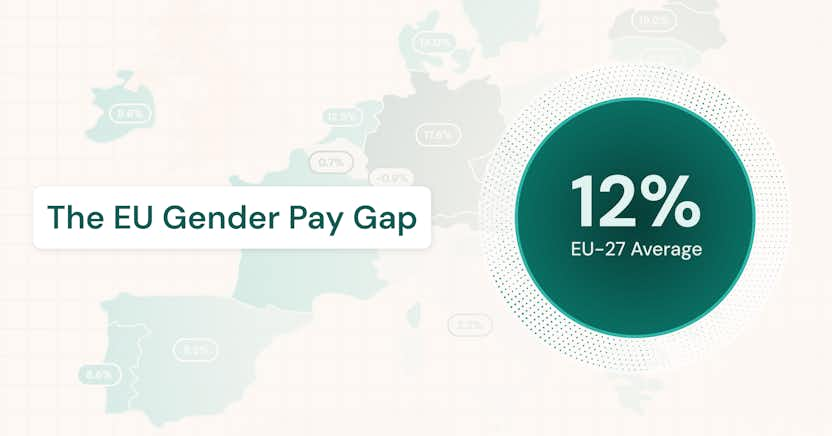A Comprehensive Guide to a Merit Increase Policy

Learn more about the following beqom products
In today's competitive job market, virtually every company recognizes the importance of having a merit increase policy to retain, motivate, and reward top talent. Merit increases, which are salary raises based on employee performance, play a crucial role in acknowledging and fostering positive behaviors within the workforce. These increases not only encourage employees to excel but also drive the overall success of the organization.
While many companies already have some form of merit increase policy in place, understanding the nuances and best practices can help optimize its effectiveness. In this blog, we'll explore the advantages, disadvantages, and key strategies for implementing a merit increase policy that aligns with your company's goals. Whether you're refining an existing policy or starting from scratch, our step-by-step guide will help you create a system that truly rewards and motivates your employees.
What is a merit increase?
A merit increase is a form of financial incentive that resembles a pay raise and is granted to employees based on their individual performance within the organization. Merit increases are often awarded through the performance evaluation process, where managers assess employees on various criteria such as their productivity, quality of work, initiative, teamwork, and overall impact on the organization’s success.
Merit increase vs. merit pay
Merit pay, also known as pay-for-performance or incentive pay, is a type of compensation that's based on a set of criteria set by the employer. It can take many forms, including salary increases, bonuses, profit sharing, stock options, and more. Merit pay is intended to incentivize employees and show an employer's commitment to valuing excellence.
A merit increase is a pay raise that's based on an employee's skills and performance at work. It's usually a permanent raise that's based on persistent performance metrics. Some companies give merit increases annually, while others may give them in response to exceptional work. Merit increases can also be part of a promotion.
What is the difference between a salary adjustment and a merit increase?
While merit increases and salary adjustments both involve changes to an employee's compensation, their purposes and implementation differ.
Unlike merit increases, salary adjustments are not necessarily tied to individual employee performance and contributions. Instead, salary adjustments address broader factors such as market competitiveness or equity within the organization. They are often applied uniformly across certain employee groups or the entire organization and do not necessarily vary based on individual performance evaluations.
Benefits of merit increases
The primary advantages of implementing merit increases include:
- Morale: Merit increases can boost employee morale by acknowledging and rewarding efforts, contributions, and achievements. Through this recognition, employees will be motivated to perform at high levels and strive for continuous self-improvement.
- Competitiveness: Offering merit increases helps organizations remain competitive in the job market by attracting top talent, as the company displays its commitment to valuing and investing in its employees’ accomplishments.
- Retention: Merit increases can reinforce loyalty and commitment among employees, who have more incentive to stay within the organization for a long time rather than seek other opportunities, thereby reducing costs associated with turnover.
- Goal alignment: Through merit increases, organizations link their workforce’s performance with their own objectives, prompting both parties to work towards common goals, increasing efficiency and innovation throughout the company.
- Equity: By implementing merit increases, organizations establish fairness and transparency in their compensation practices, allowing them to build trust with employees and contribute to a positive and collaborative work environment.
Drawbacks of merit increases
Despite these advantages, there are several potential drawbacks to consider when planning to implement merit increases, such as:
- Cost: Implementing merit increases can significantly increase the organization’s compensation expenses, straining budgets and potentially impacting other areas within the company.
- Bias: Merit increases based on subjective performance evaluations may introduce inconsistencies or instances of unfairness, as decisions rely on the perception of managers or team leads, who may be influenced by personal preferences and unconscious biases.
- Administration: The merit increase administration process can be time-consuming for HR departments, as it requires the careful coordination of performance evaluations and the considerate allocation of financial resources.
- Conflicts: Merit increases can create competition among employees, potentially causing tension and leading to conflicts over limited reward pools and perceptions of favoritism.
- Individualism: Focusing solely on individual performance for merit increases may overlook the importance of teamwork, potentially undermining team collaboration and encouraging team members to prioritize personal achievements over collective goals.
Most of these issues can be avoided or mitigated through the use of a compensation management platform that streamlines the planning and distribution of merit increases, and enables data-driven decision-making.
Alternatives to merit increases
Although a merit increase policy can benefit companies by boosting morale and aligning employee efforts with organizational goals, its cost and complex implementation, among other disadvantages, may suggest the need for alternative solutions.
Organizations can choose to offer other incentives to encourage positive behaviors and actions among their workforce, including:
- Recognition programs: The celebration and praise of individual employee achievements and contributions through ceremonies or public acknowledgments.
- Non-monetary awards: Tokens of appreciation given to employees for exceptional performance or reaching milestones, such as certificates, gift cards, and discounts.
- Career development opportunities: Programs such as workshops and training sessions designed to support employees in improving their skills, knowledge, and career growth within the organization.
- Flexible work arrangements: Employees have the opportunity to adjust their work schedules, including modifying their hours or working remotely.
- Paid Time Off (PTO): Employees receive an additional one or two PTO days per year.
- Bonuses: Monetary rewards based on individual or team performance, including profit-sharing bonuses, commission bonuses, and spot bonuses.
What is a typical merit increase?
A typical merit increase ranges between 3% to 5% of the employee’s salary. However, the actual percentage awarded can vary depending on several factors, including:
- Employee’s role: Employees with high-impact responsibilities or senior positions may be more likely to receive higher or more regular merit increases.
- Company performance: A company’s financial state can impact merit increase decisions, and a solid financial performance might allow for more generous merit increases.
- Employee performance: An employee’s work quality, productivity, engagement, and influence on other team members, among other performance factors, can determine the size of their merit increase.
- Length of employment: Long-term employees who have demonstrated their loyalty to the company may be rewarded with more substantial merit increases to encourage other employees to aim for long-term tenure.
Organizations may also consider budgetary constraints, external factors such as inflation, and the presence of other financial rewards to ensure that merit increases are competitive and deliver the desired outcomes, motivating employees while remaining a sustainable initiative.
How often should merit increases be given?
Merit increases are often awarded annually or semi-annually and are aligned with performance reviews where employees’ contributions and achievements over the past year or six months are evaluated.
While companies may be concerned that more frequent merit increases could be more costly or set expectations too high, it is also true that employee needs and expectations are changing. Companies increasingly are seeking the ability to deliver more tailored and timely rewards. As outlined in Rewarding the Moments that Matter, some companies are exploring new models for performance and rewards that are more employee-centric and provide more timely rewards without adding additional cost.
How to determine merit increases for employees
Determining merit increases involves a systematic approach that HR can facilitate smoothly through strategic planning and an HR Technology Stack for 2024. The tactical utilization of various tools and software applications enhances accuracy, transparency, and efficiency in evaluating performance and allocating merit increases.
With these tools and strategies, HR can effectively execute a five-step process to determine merit increase eligibility and size for the entire organization’s workforce:
1. Establish budget
HR begins by defining the total budget for merit increases, which should be a percentage of the overall payroll and coordinated with the organization’s financial performance. The budget is then proportionally distributed across departments based on performance and contribution to organizational objectives.
Clear guidelines for how merit increases will be allocated within each department are developed to maintain fairness and transparency. Continuous tracking of budget usage ensures spending adheres to established limits, and managers are instructed in optimal financial practices to make informed and financially responsible decisions.
2. Evaluate employee performance
HR develops specific performance metrics that are directly tied to job responsibilities and organizational goals. These metrics provide a basis for the objective assessment of employee contributions. Aligning these criteria with each role is crucial to ensure an accurate evaluation of individual performance across different positions.
3. Assess the impact of merit increase
An assessment can be conducted of the overall impact of proposed merit increases on employee motivation, retention, and organizational performance. This includes analyzing how merit increases influence employee behavior and whether they effectively drive desired outcomes. Ensuring pay equity in the merit increase process is vital at this stage, and HR is advised to use data analytics to compare merit increases across different demographics and roles to identify and address any disparities, promoting fairness and consistency.
4. Determine increase amount
Based on performance evaluations, budget constraints, and equity considerations, HR determines the specific increase amount for each eligible employee. Advanced compensation management software can assist in automating this calculation, ensuring accuracy and a comprehensive analysis of salary adjustments.
5. Adjust policy as needed
After implementation, review and adjust the merit increase policies and procedures to address any inefficiencies or shortcomings.
Regular audits of the merit increase outcomes help to refine the process, ensuring it remains fair, transparent, and aligned with evolving organizational goals and employee expectations. This continuous improvement approach ensures that the merit increase process remains effective and equitable over time.
Merit increases best practices
To maximize the effectiveness of merit increases and avoid common drawbacks such as bias, conflict, and inconsistency, implement the following best practices:
Reduce bias
Bias can be reduced by establishing clear and standardized evaluation criteria that are directly tied to job responsibilities and objectives, ensuring that assessments are based on objective performance metrics rather than subjective opinions. Managers and other evaluators can also be trained to identify and mitigate biases, including unconscious biases, that may influence decision-making.
Organizations may choose to anonymize performance data during evaluations whenever possible to ensure that discussions and decisions are based solely on employees’ achievements rather than their personal characteristics. If there is still a perception of bias, several evaluators can be involved in the assessment process to provide diverse perspectives and ensure consistency.
Conduct reviews of policies
Merit increase policy reviews involve assessing performance evaluation criteria and merit allocation to improve fairness and sustainability. Conducting them on a regular basis enables organizations to pinpoint gaps or discrepancies in policy implementation, allowing for refinement that solidifies the process’s positive outcomes.
Businesses can also solicit feedback from employees and managers about the merit increase process, which offers valuable insights into its effectiveness, fairness, and impact on employee motivation. Gathering feedback allows organizations to understand employees’ perspectives, identify areas of improvement, and make informed decisions to optimize the merit increase process for better overall results.
Communicate merit increase criteria
Effective communication of merit increase criteria helps employees understand how their contributions are evaluated and rewarded within the organization.
When organizations communicate these criteria, they establish clear expectations for employees. This clarity helps employees understand the specific standards in which their performance will be measured. It also provides them with a roadmap or guidance on what they need to achieve in order to be considered for merit increases.
Through transparent communication, employees can see the direct link between their efforts and accomplishments and the recognition they receive, which motivates them to perform at their best.
Ensure consistency
Establishing explicit guidelines for evaluating performance and determining merit increases can maintain consistency. Organizations are advised to conduct regular calibration sessions among evaluators to facilitate discussions and alignment on performance ratings, thereby reducing potential variations in assessment practices that might create perceptions of unfairness or inequity.
Effectively manage merit increases to motivate employees with beqom
Ensure your merit increase policy is fair, sustainable, and equitable with beqom’s complete compensation solution. At the same time, you can support top performance with beqom’s performance management software. Through this software, HR managers can gain valuable insight into employees’ behavior and achievements and can clearly communicate merit-increase goals. By doing so, they can enable the merit increase incentive to be thoughtfully implemented for maximum positive impact on employee satisfaction, motivation, retainment, and overall performance.
Contact beqom for more information on using technology to support performance based pay.







